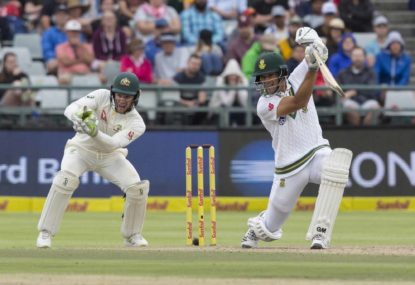183 days, 1000 runs, two centuries, average 55.55.
Aiden Markram’s first day in Test cricket started just as it does for any debutant on the big stage, excitement and apprehension competing for ascendance as he walked out to bat against Bangladesh. But once he took guard, the apprehensions melted away.
He knew he belonged here. By the end of that 29th day of September 2017, the world knew it as well.
At the press conference that evening, the questions for young Markram centered not around his innings but his disappointment at being run out for 97 when he looked all set for a century on debut.
With partner Dean Elgar on 99, Markram had selflessly backed up to allow Elgar to complete his century. But Elgar decided it was too risky and turned back leaving Markram stranded.
The debutant’s response to the questions spoke volumes about the attitude and future of the youngster: “I am more than happy with 97. If you had asked me yesterday that I will get that score I would have taken it.”
The first six months
Markram’s poise, confidence and abilities would be on show in no uncertain manner over the next six months.
Making his debut at the outset of the busiest home season in Test cricket South Africa has experienced in some time, Markram would quickly show himself to be the rock that the Proteas had been seeking at the top of the order. His first century would only be a week or so in coming as he scored a beautiful 143 in his second Test against the same opposition, following it up with 125 against Zimbabwe three months later.
At this stage his average was a Bradmanesque 95.00.
Then Virat Kohli’s India came to town for a showdown between two of the top three Test teams in the world.
It appeared as if the Indian fast bowlers had his measure when he was dismissed for five and 34 in the Cape Town Test as South Africa took a 1-0 lead. At the Centurion in the next Test, Markram would score 94 before falling victim to Ashwin.
South Africa would win the Test and take a 2-0 unassailable lead.
In the final Test on a fast uneven pitch that would later be deemed ‘below par’, South Africa would fall victim to their own plot of demanding a surface that provided assistance for their pacers in order to achieve a 3-0 whitewash.
India would demonstrate tremendous resilience and spirit in carving out a famous victory employing a quartet of pacemen and no spinners in a Test match for the first time in almost four decades.
And then in a four Test series against Australia that will unfortunately be remembered more for its on-field and off-field exchange of abuse and sandpaper grazed bursting of a cheating bubble than for its cricket, Markram would put in some stellar performances.
Markram would stand tall and deliver a magnificent 143 in the second innings at Durban while his team fell apart like a pack of cards, but would not be able to save the Test match. In the third Test Markram would be the highest scorer and with Morne Morkel running through the Aussies to help the Proteas win the Test.
In the final Test a superb 152 with 17 fours and a six in the first innings would be instrumental in South Africa’s eventual match and series victory. And as he scored his 37th run in the second innings, Aiden Markram would complete 1000 runs on his 285th day in Test cricket.
Virat Kohli the world’s best batsman currently across formats would call him “a treat to watch.”
How good has the start of Markram’s career been?
Impressive. Sceptics could however suggest that the dawn does not always predict the day, and in the 140-years of Test cricket there have been many instances of players whose stunning debuts have faded away into inexplicable declines. So making a prediction about Markram’s future is an exercise in futility.
Perhaps, but history suggests otherwise.
Markram completed his 1000th run in his 10th Test match. That immediately puts him in august company. Only ten batsmen in the history of Test cricket have scored 1000 runs within their first ten Test matches. Each of them has made an impact on world cricket over the course of their career, some more than others.
But Markram has a further distinction. He made these runs in his first six months, while all the others on this list took far longer, either due to scheduling of matches or because they were dropped for one or more Tests in between.
On average, most of these ten batsmen managed to complete six Tests in their first six months, so to level the playing field, I decided to compare their records at the end of sixth Test that each played.
The results are interesting, starting with the first fact that in his first six Tests Aiden Markram scored only 520 runs, which is the second lowest among the group, and yet by his 10th he had reached 1000, showing more acceleration than most on the list.
Unsurprisingly, leading the list is the 99.94 man, Sir Donald Bradman, who reached the 1000 runs milestone in his seventh Test match. In his first six Tests Bradman scored 862 runs accompanied by four centuries including an innings of 254.
Achieving the 1000 runs mark in their ninth Test were three of the world’s greatest cricketers – Herbert Sutcliffe of England, Sir Everton Weekes and George Headley of the West Indies.
Herbert Sutcliffe, perhaps the world’s greatest opening batsman along with Jack Hobbs, would end his career with an average of 60.73. In his first six Tests Sutcliffe would have two centuries much like Markram, and only 477 runs against his name, accelerating to 1000 by his ninth Test.
Sir Everton Weekes would accumulate 615 runs in his first six Tests with three centuries and end his career with an average of 58.61.
George Headley had a phenomenal debut scoring 176 and piling up 730 in his first six Tests accompanied by a remarkable four centuries. He would finish with a career average of 60.83.
There are five batsmen who achieved the 1000 runs mark in ten Tests along with Markram – Neil Harvey and Mark Taylor from Australia, Sir Frank Worrell from the West Indies, Andrew Strauss and Gary Ballance from England.
Neil Harvey, the second member of the 1948 Invincibles team in this list would score 534 in his first six Tests with three centuries. Over a remarkable Test career that spanned much of two decades when he was the mainstay of the Australian batting, Harvey would achieve a career average of 48.41.
Mark Taylor, one of Australia’s most respected captains, would score 568 in his first six Tests with one century to boot, but end his career with a relatively modest average (in comparison to this group) of 43.49, largely thanks to his captaincy pressures.
Sir Frank Worrell, a giant of West Indian cricket, would pile up 695 runs in his first six Tests with two centuries, including a magnificent 261. Worrell would end his career with an average just a shade below 50.
Garry Ballance started his career with much promise, stroking his way to 628 runs including three centuries in his first six Tests. His pace and form have fallen off a bit since then and he currently has an average of 47.16 with much of his career presumably ahead of him.
Andrew Strauss scored 112 on debut and went on to make 640 runs in his first six Tests with two centuries. He would however have a relatively lacklustre second half to his long career, major personal issues to tackle and sadly end his career with a disappointing average just below 41.00.
Finally, the only man to take less time (164 days) but more Tests (11 to Markram’s 10) to 1000 runs (which is why he is not in the original list of 10), Mike Hussey of Australia scored 640 runs in his first six Tests with three centuries. Hussey would end his career with an average of 51.52.
Extrapolating the past
Any extrapolation from history as the state of being of the future is undoubtedly fraught with the danger of failed predictability. Nonetheless, given the parameters chosen for the comparison and the robust results that one finds, it is perhaps worth the risk of putting some virtual money on Markram.
Let us consider the facts thrown up by our analysis.
None of the ten other batsmen who make up the set of players we studied here have ended their careers with an average below 40 and indeed six of them have averaged above 50.
Arguably eight of the ten have had the tag of greatness attached to them by the time they have laid down their bat, not only within their country, but across the cricketing community.
Other than Bert Sutcliffe and Neil Harvey, no one in the list has moved on to a steeper slope between their sixth and 10th Test matches, exhibiting a trajectory that can only be positive for the young man.
No other South African bar one has had a similar start to their career. That man was Graeme Smith who reached his 1000th run in his 12th Test match with a single century (a double) against Bangladesh.
Smith would end his career as South Africa’s most successful captain, an average of 48.12 and 27 centuries against his name.
South Africa’s man for the future
Whichever way one looks at it, Markram is the brightest batting spark that South Africa has pulled out of its closet in a long time. History is on his side, his performances thus far are outstanding and South Africa would do well to nurture this talent, encourage him, support him and stick with him through the bad patches that he will undoubtedly have as a batsman.
In time, as he sets off into the sunset, perhaps a decade and a half from now, the name of Aiden Markram may well be near the top as the new list of South African greats with the bat are compiled.





































































































